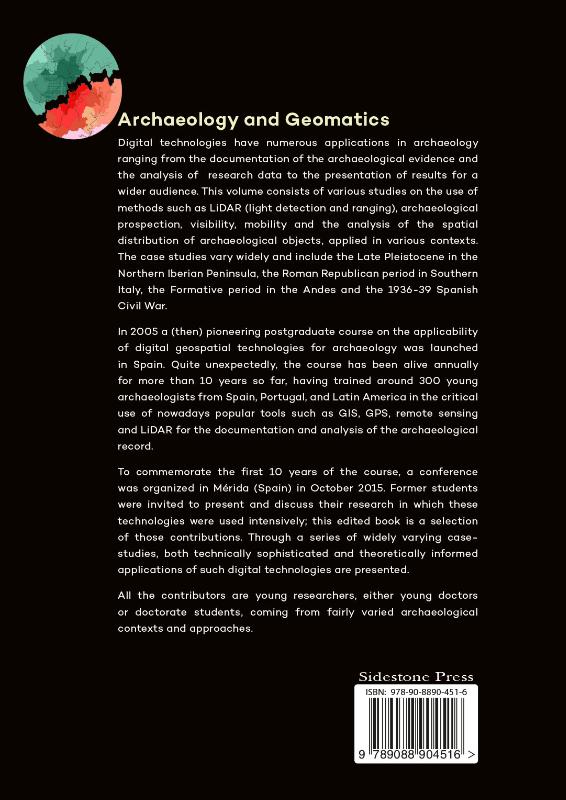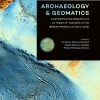Archaeology and Geomatics
€ 135,00
Harvesting the benefits of 10 years of training in the Iberian Peninsula (2006-2015)
Mayoral Herrera, Victorino | Hardback | 08-01-2018 | 9789088904523 |
Levertijd 5 dagen
Digital technologies have numerous applications in archaeology ranging from the documentation of the archaeological evidence …
Harvesting the benefits of 10 years of training in the Iberian Peninsula (2006-2015)
Mayoral Herrera, Victorino | Hardback | 08-01-2018 | 9789088904523 |
Levertijd 5 dagen
Digital technologies have numerous applications in archaeology ranging from the documentation of the archaeological evidence and the analysis of research data to the presentation of results for a wider audience. This volume consists of various studies on the use of methods such as LiDAR (light detection and ranging), archaeological prospection, visibility, mobility and the analysis of the spatial distribution of archaeological objects, applied in various contexts. The case studies vary widely and include the Late Pleistocene in the Northern Iberian Peninsula, the Roman Republican period in Southern Italy, the Formative period in the Andes and the 1936-39 Spanish Civil War.
In 2005 a (then) pioneering postgraduate course on the applicability of digital geospatial technologies for archaeology was launched in Spain. Quite unexpectedly, the course has been alive annually for more than 10 years so far, having trained around 300 young archaeologists from Spain, Portugal, and Latin America in the critical use of nowadays popular tools such as GIS, GPS, remote sensing and LiDAR for the documentation and analysis of the archaeological record.
To commemorate the first 10 years of the course, a conference was organized in Mérida (Spain) in October 2015. Former students were invited to present and discuss their research in which these technologies were used intensively; this edited book is a selection of those contributions. Through a series of widely varying case-studies, both technically sophisticated and theoretically informed applications of such digital technologies are presented.
All the contributors are young researchers, either young doctors or doctorate students, coming from fairly varied archaeological contexts and approaches.
Contents:
Introduction
Unboxing the black box. Lessons learnt from ten years of teaching geospatial technologies to archaeologists.
by Victorino Mayoral Herrera, César Parcero-Oubiña and Pastor Fábrega-Álvarez
Section 1. Shapes and locations. Documenting and characterizing the archaeological record
Pursuing ancient rural life through surface survey: composition and diversity of artifact distributions.
by Luis Antonio Sevillano Perea
Experiments on Roman surface scatters through digital survey methods: study cases from Odra-Pisuerga region, (Burgos, Spain).
by Jesús García Sánchez
Scope and limitations of airborne LiDAR technology for the detection and analysis of Roman military settlements in Northwest Iberia.
by José Manuel Costa García and João Fonte
Making Visible the Invisible: Low Cost Methodologies for the Study of Ancient Carvings.
by Miguel Carrero-Pazos, Benito Vilas-Estévez and Alia Vázquez-Martínez
Section 2. Tools and methods. Procedural approaches
Methods for the evaluation of the visualization of archaeological sites
by Pablo Paniego Díaz
Landscapes on the move. Digitally exploring the relationship between megaliths and mobility in Northern Cáceres (Spain).
by Jose M. Señorán Martín
The answer is blowing in the wind: a method to measure wind-protection as a criterion for settlement in the past.
by Marcos García García
Section 3. Patterns, behaviour, decisions. Analysing the archaeological evidence
Application of GIS to flint management studies during the Pleistocene to Holocene transition: the case of Baltzola (Dima, Bizkaia, Spain).
by Maite García-Rojas, Alejandro Prieto, Aitor Sánchez, Cristina Camarero and Lydia Zapata
The Archaeology of Rock Art as Archaeology of the Mediterranean Landscape.
by María Sebatián López
Building landscapes: a landform approach for the Iron Age sites in the Upper Duero River.
by Raquel Liceras-Garrido, Enrique Cerrillo-Cuenca and Alfredo Jimeno-Martínez
GIS contribution to the analysis of the distribution of Roman caves between the Ebro River and the Pyrenees.
by Leticia Tobalina Pulido, Benoît Pace and Alain Campo
The potential of the Geographic Information Techniques for the analysis of the morphology and settlement patterns of the Roman military sites of early imperial era in Iberia.
by José Manuel Costa-García
Centering Tafí: A political approach to the landscape of a Southern Andes Formative community.
by Jordi A. López Lillo
Landscapes of War. GIS applications in the study of the Spanish Civil War.
by Manuel Antonio Franco Fernández and Pedro Rodríguez Simón
Section 4. Archaeology and the public. Disseminating to a wider audience
Geographic Information Systems: an effective tool for the management of the Cultural Heritage of Cantabria.
by Gustavo Sanz Palomera
A map for Gondar. Cartographic system for the touristic development of the Amhara Region (Ethiopia)
by Cristina Charro Lobato, Eduardo Martín Agúndez and Agustín Cabria Ramos
Discussion and comments
by Martijn van Leusen
| Gewicht | 1,005 kg |
|---|---|
| Afmetingen | 26,4 × 18,8 × 2,3 cm |
| Taal | Engels |
| Uitvoering | Hardback |
| Auteur | Mayoral Herrera, Victorino |
| Verschijningsjaar | 2018 |
| ISBN | 9789088904523 |
| Leverdagen | 5 |







